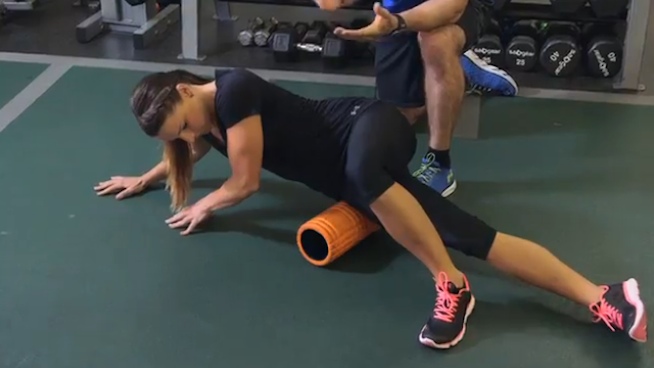Foam Rolling Techniques to Fix Every Trouble Spot on Your Body
Foam rolling is one of the easiest, safest and most effective ways to alleviate tight muscles and improve physical performance. As a result, foam rolling is one of the most frequently recommended warm-up and recovery methodologies by strength coaches, physical therapists and athletic trainers.
As with any type of training method, some approaches work better than others. Let’s look at how to get the most of your foam rolling routine and how to avoid common mistakes.
- Foam Rolling Benefits
- How Do I Use a Foam Roller?
- How to Foam Roll Your Back
- How to Foam Roll Your Calves
- How to Foam Roll Your IT band and Quads
- How to Foam Roll Your Hamstrings
- How to Foam Roll Your Shoulders
- Why Type of Foam Roller Should I Use?
Foam Rolling Benefits
Foam rolling is a type of self-myofascial release—often referred to as SMR. This is a method used to alleviate tension in muscles, improve blood flow and accelerate the recovery process. It is accomplished by applying pressure to the muscles by rolling or kneading, similar to a massage. The difference is, you do it on your own.
It was initially thought that foam rolling broke down adhesions—also called knots or trigger points—and actually changed the structure of the muscle and connective tissue, or fascia, that surrounds the muscles.
According to Dr. John Rusin, strength coach, physical therapist and owner of John Rusin Fitness Systems, this isn’t necessarily the case.
“Some preach the ability to mechanically break up scar tissue and adhesions in soft tissue,” he says. “Research is showing that there’s very little mechanical breakdown of these tissues—maybe only 5 percent.”
It takes far too much force to actually alter the structure of muscle and fascia, especially in the short term. Instead, the primary benefit of foam rolling is to reduce the neurological activity, or tone, of the muscle.
“Essentially what you’re doing with foam rolling is taking muscles that are in a really tense state, and trying to make them chill just a bit,” explains Dean Somerset, strength coach, exercise physiologist and owner of DeanSomerset.com.
Somerset explains that contracting a tense muscle with bound up fascia is like trying to drive a car with the emergency brake engaged. The muscle and fascia fight against each other, making it impossible for the muscle to perform as it’s supposed to.
“Foam rolling allows muscles to move without the pressure of fascial resistance that might be fighting against it so everything can contract and relax together,” adds Somerset. “For a muscle to work properly, it needs to contract and relax at the same time. If it’s always in a state of constant excitation, it’s not really going to work all that easily.”
It appears that foam rolling also helps increase range of motion. For example, foam rolling your quads should improve range of motion at your hips. The quad is able to move through an increased length, which allows the hip joint to move through a greater range of motion.
And finally, foam rolling can aid in the recovery process after an intense workout. “After you train, you’re going to have some inflammation and local blood flow in the areas you concentrated on,” explains Rusin. “SMR allows you to care for those tissues and expedite the healing process.”
A faster and more effective recovery allows your body to rebuild your muscles after training and be prepared for the next workout or sporting event.
But does foam rolling impair performance?
This has been a major concern with foam rolling before workouts. For a long time it was thought that foam rolling temporarily impairs strength, so it should be avoided before a workout. This has been a hot debate with several conflicting studies.
However, recent research (1, 2) shows that foam rolling has a negligible impact on strength. The only issue is countermovement jump performance, which refers to when you quickly bend your hips and knees and then jump up. According to Somerset, this can easily be reversed with a dynamic warm-up that includes a few jumping drills.
So fear not, foam rolling is in fact OK to do before a workout and even between sets of exercises and drills. When we were observing NFL prospects training for the Combine at EXOS (Phoenix), the athletes rolled their quads and hamstrings between sets of Sprints.
How do I use a foam roller?
Foam rolling might look incredibly easy, but many people perform it haphazardly and fail to receive its benefits. Here are Somerset’s guidelines for effective foam rolling:
How often to foam roll
Foam rolling is like brushing your teeth. Do it once a day to maintain your muscles and fascia, but no more. Too much foam rolling can overly stress your tissues—especially if you have an aggressive rolling routine. This is a case where you can do too much of a good thing.
When to foam roll
Any time is a good time to roll. You can do it when you wake up, before you go to bed, before a workout, after a workout or between sets as active recovery. That said, before a workout is the best time to take full advantage of the benefits of foam rolling.
How long to foam roll
Your complete foam roll routine should take about 5-10 minutes. Spend about a minute rolling each of your major muscles, focusing on painful areas or adhesions. When you find a painful area, stay on it for at least 10-15 seconds, which is typically the amount of time it takes to release tension.
What muscles to foam roll
The most common areas to foam roll include the calves, hamstrings, quads, glutes, IT band (more on this later), lats, upper back, chest and shoulders. However, you can target any major muscle groups as long as you don’t roll over a joint or bone, which can cause pain and tissue damage. For example, foam roll to just above your knee and just below your hip when working on your quads.
How fast to roll
Many people make the mistake of rolling back and forth quickly. It might feel good, but it’s not doing much to alleviate tension. Instead, move slowly up and down the length of the muscle and focus on the thickest part of the muscle. Search for painful areas and give those spots extra attention. For every 2 inches you roll, roll backwards 1 inch. Also, remember to breath—each inhale and exhale should take about 3-5 seconds.

Don’t foam roll like this.
Is foam rolling painful?
Foam rolling can feel great but can also be quite painful when you find a tender area. On a pain scale of 1-10 where 10 is equivalent to getting mauled by a bear, foam rolling should be no more than a 4.
How to Foam Roll Your Back – What to do and what NOT to do
If you want to foam roll your back, focus rolling slowly over your middle and upper back. However, Somerset advises to proceed with caution as there are many sensitive structures in your spine. It’s better to shift slightly to each side and roll your lats and traps—the large muscles on each side of your spine. If you have tightness in your upper-back, try these upper-back stretches rather than relying on a foam roller.
Also, avoid rolling your lower back, or lumbar spine. This causes people to move into a heavy arched position, which can exacerbate back pain. The lower-back muscles should be rigid to protect the spine—rolling decreases tension, which is the exact opposite of what you want to do. Also, lower-back pain typically is the result of another issue in your body, so rolling won’t do much good.
RELATED: The Complete Solution for Fixing Lower-Back Pain
How to Foam Roll Your Calves
Start with one calf on a roller, slowly rolling the area just under calf muscle to hit your soleus. Work your way up your calf to the large portion of the muscle and spend time rolling the inside, middle and outside portion of the muscle. Avoid rolling your Achilles tendon, which the is the thick tendon that runs down the backside of your ankle.
[youtube video=”y1NOL7IApsE” /]How to Foam Roll Your IT band and Quads
The quads comprise a large muscle group that can become gummed up if you don’t tend to it. Start with one quad on a roller just above your knee and work your way up to the top of your thigh, keeping a slightly bent knee to create some length in the muscle. Just like the calves, focus on the inside, middle and outside portion of the muscle.
[youtube video=”-O7j7FRBzis” /]There’s some debate over whether or not to roll the IT Band. Some swear by it while others claim it’s not effective and may actually increase inflammation in this thick length of fascia that runs down the side of your leg. So it’s best to focus rolling on the outside of your quads and hamstring, which run along the frontside and backside of the IT Band. That said, many people enjoy foam rolling their IT band and you can continue doing so as long as it doesn’t cause pain.
[youtube video=”3XrK34k5dm0″ /]How to Foam Roll Your Hamstrings
Foam rolling your hamstrings can reduce tightness and tension—a problem many of us experience in this often overactive muscle group. Foam rolling the hamstrings likely won’t feel as intense as rolling the quads because it’s a bit harder to put pressure on the muscle, but that doesn’t mean it’s not working. Start with one hamstring on a roller just above your knee and work up towards your hip, focusing on the inside, middle and outside of the muscle.
[youtube video=”dpgkYfzf930″ /]How to Foam Roll Your Shoulders
You can directly foam roll your deltoids, which are the round muscles that sit on the sides of your shoulders. However, tightness is typically associated with muscles on the front of your body, especially your chest. To roll your pecs, place a roller at a 45-degree angle to your body and focus on the area between the middle of your chest and your shoulder.
[youtube video=”CtFHN6f4-s4″ /]Another common cause of tight shoulders is the lats, which are the muscles that run down the sides of your back under your armpits. Tight lats can make it difficult to lift your arms overhead without arching your lower back—a common cause of low-back pain. Lie with the meaty part of your lats just under your armpit on a roller and slowly rotate your upper body back and forth as shown in the video below.
[youtube video=”pq7gIqiqdq4″ /]Why Type of Foam Roller Should I Use?
A standard foam roller that typically cost about $30-$40 will do the job for most foam rolling exercises. You will have to choose the density of the foam roller, which dictates the pressure placed on your muscles. Start with a lower density roller if you’re new to foam rolling so it’s not too painful. Our go-to rollers are from Trigger Point, which offers a variety of foam roller products.
Some advocate using a PVC pipe for extreme foam rolling, but this should only be done under supervision of a professional.
The broad surface of a roller sometimes might not be able to effectively target hard-to-get areas. In this case, use a lacrosse ball or even your hands if you can reach the spot.
READ MORE:
RECOMMENDED FOR YOU
MOST POPULAR
Foam Rolling Techniques to Fix Every Trouble Spot on Your Body
Foam rolling is one of the easiest, safest and most effective ways to alleviate tight muscles and improve physical performance. As a result, foam rolling is one of the most frequently recommended warm-up and recovery methodologies by strength coaches, physical therapists and athletic trainers.
As with any type of training method, some approaches work better than others. Let’s look at how to get the most of your foam rolling routine and how to avoid common mistakes.
- Foam Rolling Benefits
- How Do I Use a Foam Roller?
- How to Foam Roll Your Back
- How to Foam Roll Your Calves
- How to Foam Roll Your IT band and Quads
- How to Foam Roll Your Hamstrings
- How to Foam Roll Your Shoulders
- Why Type of Foam Roller Should I Use?
Foam Rolling Benefits
Foam rolling is a type of self-myofascial release—often referred to as SMR. This is a method used to alleviate tension in muscles, improve blood flow and accelerate the recovery process. It is accomplished by applying pressure to the muscles by rolling or kneading, similar to a massage. The difference is, you do it on your own.
It was initially thought that foam rolling broke down adhesions—also called knots or trigger points—and actually changed the structure of the muscle and connective tissue, or fascia, that surrounds the muscles.
According to Dr. John Rusin, strength coach, physical therapist and owner of John Rusin Fitness Systems, this isn’t necessarily the case.
“Some preach the ability to mechanically break up scar tissue and adhesions in soft tissue,” he says. “Research is showing that there’s very little mechanical breakdown of these tissues—maybe only 5 percent.”
It takes far too much force to actually alter the structure of muscle and fascia, especially in the short term. Instead, the primary benefit of foam rolling is to reduce the neurological activity, or tone, of the muscle.
“Essentially what you’re doing with foam rolling is taking muscles that are in a really tense state, and trying to make them chill just a bit,” explains Dean Somerset, strength coach, exercise physiologist and owner of DeanSomerset.com.
Somerset explains that contracting a tense muscle with bound up fascia is like trying to drive a car with the emergency brake engaged. The muscle and fascia fight against each other, making it impossible for the muscle to perform as it’s supposed to.
“Foam rolling allows muscles to move without the pressure of fascial resistance that might be fighting against it so everything can contract and relax together,” adds Somerset. “For a muscle to work properly, it needs to contract and relax at the same time. If it’s always in a state of constant excitation, it’s not really going to work all that easily.”
It appears that foam rolling also helps increase range of motion. For example, foam rolling your quads should improve range of motion at your hips. The quad is able to move through an increased length, which allows the hip joint to move through a greater range of motion.
And finally, foam rolling can aid in the recovery process after an intense workout. “After you train, you’re going to have some inflammation and local blood flow in the areas you concentrated on,” explains Rusin. “SMR allows you to care for those tissues and expedite the healing process.”
A faster and more effective recovery allows your body to rebuild your muscles after training and be prepared for the next workout or sporting event.
But does foam rolling impair performance?
This has been a major concern with foam rolling before workouts. For a long time it was thought that foam rolling temporarily impairs strength, so it should be avoided before a workout. This has been a hot debate with several conflicting studies.
However, recent research (1, 2) shows that foam rolling has a negligible impact on strength. The only issue is countermovement jump performance, which refers to when you quickly bend your hips and knees and then jump up. According to Somerset, this can easily be reversed with a dynamic warm-up that includes a few jumping drills.
So fear not, foam rolling is in fact OK to do before a workout and even between sets of exercises and drills. When we were observing NFL prospects training for the Combine at EXOS (Phoenix), the athletes rolled their quads and hamstrings between sets of Sprints.
How do I use a foam roller?
Foam rolling might look incredibly easy, but many people perform it haphazardly and fail to receive its benefits. Here are Somerset’s guidelines for effective foam rolling:
How often to foam roll
Foam rolling is like brushing your teeth. Do it once a day to maintain your muscles and fascia, but no more. Too much foam rolling can overly stress your tissues—especially if you have an aggressive rolling routine. This is a case where you can do too much of a good thing.
When to foam roll
Any time is a good time to roll. You can do it when you wake up, before you go to bed, before a workout, after a workout or between sets as active recovery. That said, before a workout is the best time to take full advantage of the benefits of foam rolling.
How long to foam roll
Your complete foam roll routine should take about 5-10 minutes. Spend about a minute rolling each of your major muscles, focusing on painful areas or adhesions. When you find a painful area, stay on it for at least 10-15 seconds, which is typically the amount of time it takes to release tension.
What muscles to foam roll
The most common areas to foam roll include the calves, hamstrings, quads, glutes, IT band (more on this later), lats, upper back, chest and shoulders. However, you can target any major muscle groups as long as you don’t roll over a joint or bone, which can cause pain and tissue damage. For example, foam roll to just above your knee and just below your hip when working on your quads.
How fast to roll
Many people make the mistake of rolling back and forth quickly. It might feel good, but it’s not doing much to alleviate tension. Instead, move slowly up and down the length of the muscle and focus on the thickest part of the muscle. Search for painful areas and give those spots extra attention. For every 2 inches you roll, roll backwards 1 inch. Also, remember to breath—each inhale and exhale should take about 3-5 seconds.

Don’t foam roll like this.
Is foam rolling painful?
Foam rolling can feel great but can also be quite painful when you find a tender area. On a pain scale of 1-10 where 10 is equivalent to getting mauled by a bear, foam rolling should be no more than a 4.
How to Foam Roll Your Back – What to do and what NOT to do
If you want to foam roll your back, focus rolling slowly over your middle and upper back. However, Somerset advises to proceed with caution as there are many sensitive structures in your spine. It’s better to shift slightly to each side and roll your lats and traps—the large muscles on each side of your spine. If you have tightness in your upper-back, try these upper-back stretches rather than relying on a foam roller.
Also, avoid rolling your lower back, or lumbar spine. This causes people to move into a heavy arched position, which can exacerbate back pain. The lower-back muscles should be rigid to protect the spine—rolling decreases tension, which is the exact opposite of what you want to do. Also, lower-back pain typically is the result of another issue in your body, so rolling won’t do much good.
RELATED: The Complete Solution for Fixing Lower-Back Pain
How to Foam Roll Your Calves
Start with one calf on a roller, slowly rolling the area just under calf muscle to hit your soleus. Work your way up your calf to the large portion of the muscle and spend time rolling the inside, middle and outside portion of the muscle. Avoid rolling your Achilles tendon, which the is the thick tendon that runs down the backside of your ankle.
[youtube video=”y1NOL7IApsE” /]How to Foam Roll Your IT band and Quads
The quads comprise a large muscle group that can become gummed up if you don’t tend to it. Start with one quad on a roller just above your knee and work your way up to the top of your thigh, keeping a slightly bent knee to create some length in the muscle. Just like the calves, focus on the inside, middle and outside portion of the muscle.
[youtube video=”-O7j7FRBzis” /]There’s some debate over whether or not to roll the IT Band. Some swear by it while others claim it’s not effective and may actually increase inflammation in this thick length of fascia that runs down the side of your leg. So it’s best to focus rolling on the outside of your quads and hamstring, which run along the frontside and backside of the IT Band. That said, many people enjoy foam rolling their IT band and you can continue doing so as long as it doesn’t cause pain.
[youtube video=”3XrK34k5dm0″ /]How to Foam Roll Your Hamstrings
Foam rolling your hamstrings can reduce tightness and tension—a problem many of us experience in this often overactive muscle group. Foam rolling the hamstrings likely won’t feel as intense as rolling the quads because it’s a bit harder to put pressure on the muscle, but that doesn’t mean it’s not working. Start with one hamstring on a roller just above your knee and work up towards your hip, focusing on the inside, middle and outside of the muscle.
[youtube video=”dpgkYfzf930″ /]How to Foam Roll Your Shoulders
You can directly foam roll your deltoids, which are the round muscles that sit on the sides of your shoulders. However, tightness is typically associated with muscles on the front of your body, especially your chest. To roll your pecs, place a roller at a 45-degree angle to your body and focus on the area between the middle of your chest and your shoulder.
[youtube video=”CtFHN6f4-s4″ /]Another common cause of tight shoulders is the lats, which are the muscles that run down the sides of your back under your armpits. Tight lats can make it difficult to lift your arms overhead without arching your lower back—a common cause of low-back pain. Lie with the meaty part of your lats just under your armpit on a roller and slowly rotate your upper body back and forth as shown in the video below.
[youtube video=”pq7gIqiqdq4″ /]Why Type of Foam Roller Should I Use?
A standard foam roller that typically cost about $30-$40 will do the job for most foam rolling exercises. You will have to choose the density of the foam roller, which dictates the pressure placed on your muscles. Start with a lower density roller if you’re new to foam rolling so it’s not too painful. Our go-to rollers are from Trigger Point, which offers a variety of foam roller products.
Some advocate using a PVC pipe for extreme foam rolling, but this should only be done under supervision of a professional.
The broad surface of a roller sometimes might not be able to effectively target hard-to-get areas. In this case, use a lacrosse ball or even your hands if you can reach the spot.
READ MORE:












